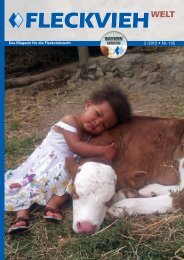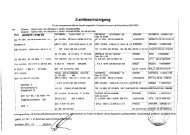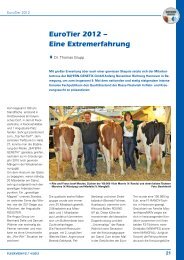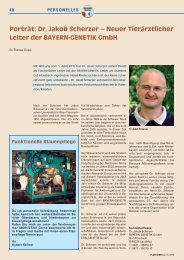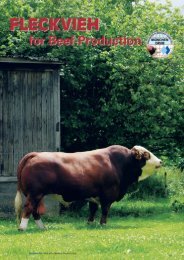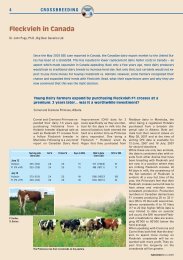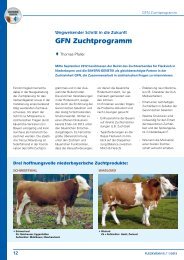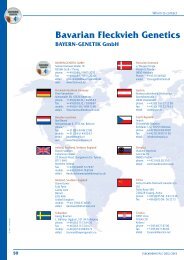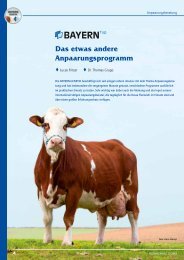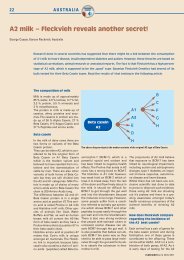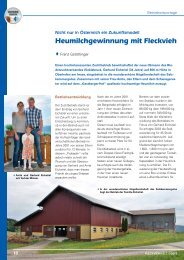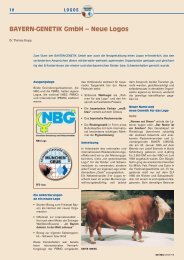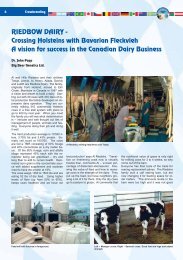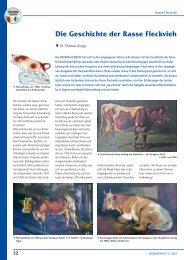Fleckvieh in the Vogtland District/ Eastern Germany
Fleckvieh in the Vogtland District/ Eastern Germany
Fleckvieh in the Vogtland District/ Eastern Germany
Create successful ePaper yourself
Turn your PDF publications into a flip-book with our unique Google optimized e-Paper software.
Local conditions<br />
The farm land is located at an<br />
altitude of 220 to 450 m, <strong>the</strong><br />
annual precipitation is 620 mm,<br />
<strong>the</strong> mean annual temperature is<br />
7° C, however it can get very cold,<br />
as for example last w<strong>in</strong>ter <strong>the</strong><br />
temperature dropped to - 24° C.<br />
The soil quality <strong>in</strong>dex is 37 po<strong>in</strong>ts<br />
for <strong>the</strong> crop land and 36 po<strong>in</strong>ts for<br />
grassland.<br />
Dairy production<br />
Two dairy farms belong to <strong>the</strong><br />
ERVEMA Agrar GmbH, one at<br />
Clodra and one at Staitz. At <strong>the</strong><br />
two locations toge<strong>the</strong>r 1430 dairy<br />
cows are kept – 830 at Staitz and<br />
600 at Clodra.<br />
Crossbreed<strong>in</strong>g<br />
<strong>Fleckvieh</strong> <strong>in</strong> <strong>the</strong> <strong>Vogtland</strong> <strong>District</strong>/<br />
<strong>Eastern</strong> <strong>Germany</strong><br />
l Theo Vermöhlen, crossbreed<strong>in</strong>g specialist of BAYERN - GENETIK and Wolfram Köber,<br />
farm manager of ERVEMA Agrar GmbH<br />
Like a blue sapphire, <strong>the</strong> Clodra Dairy Farm tw<strong>in</strong>kles <strong>in</strong> <strong>the</strong> hilly landscape of <strong>the</strong> <strong>Vogtland</strong> <strong>District</strong><br />
<strong>in</strong> Thur<strong>in</strong>gia / <strong>Eastern</strong> <strong>Germany</strong>. The farm is part of <strong>the</strong> ERVEMA Agrar GmbH, which comb<strong>in</strong>es<br />
crop production, dairy farm<strong>in</strong>g, beef farm<strong>in</strong>g and <strong>the</strong> production of bio-energy under one roof.<br />
The agricultural area of <strong>the</strong> ERVEMA Agrar GmbH ranges over 12 communities and 28 villages.<br />
They started absorption cross<strong>in</strong>g<br />
with <strong>Fleckvieh</strong> <strong>in</strong> <strong>the</strong> year 2012.<br />
S<strong>in</strong>ce <strong>the</strong>n, many th<strong>in</strong>gs changed<br />
for <strong>the</strong> better. The <strong>in</strong>tercalv<strong>in</strong>g<br />
period dropped from 410 days<br />
(Holste<strong>in</strong>) to 386 days (<strong>Fleckvieh</strong><br />
crossbreds). Due to <strong>the</strong> improved<br />
udder health and <strong>the</strong> reduction of<br />
<strong>the</strong> herd replacement rate from<br />
44 % to 26 %, <strong>the</strong> costs for <strong>the</strong><br />
veter<strong>in</strong>arian dropped about 1,5<br />
Cent per kg milk, which makes a<br />
significant difference.<br />
Currently <strong>the</strong> average milk production<br />
of <strong>the</strong> herd <strong>in</strong> Clodra is<br />
8120 kg milk. The short-term aim<br />
is 8500 kg milk per cow and year.<br />
After consolidation <strong>the</strong> mid-term<br />
goal will be to sell crossbred<br />
breed<strong>in</strong>g heifers to o<strong>the</strong>r farms.<br />
l All build<strong>in</strong>gs at Clodra dairy farm are blue.<br />
The facility at Clodra was build up<br />
new <strong>in</strong> 2010/2011: The barn has<br />
solid walk<strong>in</strong>g routes with rough<br />
concrete, cubicles with rubber<br />
mats and straw litter, curta<strong>in</strong>s on<br />
<strong>the</strong> long sides of <strong>the</strong> barn and<br />
perforated plates on <strong>the</strong> front<br />
sides. The <strong>in</strong>stallation <strong>in</strong>cludes a<br />
rotary milk<strong>in</strong>g parlour enabl<strong>in</strong>g<br />
50 cows to be milked at one time.<br />
12 FLECKVIEHWORLD 2012/2013
Crossbreed<strong>in</strong>g<br />
l Cows wait<strong>in</strong>g to be milked <strong>in</strong> <strong>the</strong> rotary milk<strong>in</strong>g parlour. l Cows <strong>in</strong> <strong>the</strong> rotary milk<strong>in</strong>g parlour at Clodra.<br />
Feed<strong>in</strong>g<br />
The feed<strong>in</strong>g is based almost only<br />
on feed produced at ERVEMA.<br />
The cows are divided <strong>in</strong>to four<br />
feed<strong>in</strong>g groups. The TMR for <strong>the</strong><br />
high performance group is adjusted<br />
regularly accord<strong>in</strong>g to <strong>the</strong><br />
results of milk record<strong>in</strong>g.<br />
The whole farm management<br />
aims at an efficient milk production,<br />
with <strong>the</strong> <strong>in</strong>come com<strong>in</strong>g<br />
from both, milk and beef production<br />
and is focused on a high<br />
lifetime production of <strong>the</strong> cows.<br />
Mr. Köber, <strong>the</strong> farm manager and<br />
<strong>the</strong> two managers of <strong>the</strong> facilities<br />
at Clodra and Staitz, Mrs. Sp<strong>in</strong>dler<br />
and Mrs. Koch are sure that <strong>the</strong><br />
<strong>Fleckvieh</strong> breed fits best with <strong>the</strong><br />
idea of long-liv<strong>in</strong>g cows, even<br />
though some cows start with a<br />
high milk production not before<br />
<strong>the</strong> second lactation.<br />
Also <strong>the</strong> ration for <strong>the</strong> high performance<br />
cows does not conta<strong>in</strong> any<br />
expensive bought <strong>in</strong> prote<strong>in</strong> feed.<br />
The gra<strong>in</strong> produced on <strong>the</strong> farm is<br />
only complemented with rape<br />
cake produced at <strong>the</strong> farm’s own<br />
rapeseed press.<br />
Suckler cows<br />
At present 70 suckler cows are<br />
kept <strong>in</strong> order to utilize <strong>the</strong> less<br />
productive grassland areas. The<br />
result<strong>in</strong>g bull calves are fattened.<br />
However, <strong>the</strong> crossbred bull calves<br />
out of <strong>the</strong> dairy herd often have<br />
<strong>the</strong> same excellent fatten<strong>in</strong>g<br />
results as <strong>the</strong> bulls out of <strong>the</strong> suckler<br />
cow herd.<br />
Fatten<strong>in</strong>g bulls<br />
Crossbreed<strong>in</strong>g with <strong>Fleckvieh</strong> led to<br />
a considerable <strong>in</strong>crease of <strong>the</strong><br />
profit of <strong>the</strong> fatten<strong>in</strong>g bus<strong>in</strong>ess.<br />
98% of <strong>the</strong> 640 crossbred fatten<strong>in</strong>g<br />
bulls are classified carcass<br />
grade U and R, whereas from <strong>the</strong><br />
pure Holste<strong>in</strong> bulls 80% were<br />
classified O and P (<strong>in</strong> <strong>the</strong> EUROP<br />
system).<br />
The results of <strong>the</strong> slaughter cows<br />
are similar. Due to a better feed<br />
conversion and a higher dress<strong>in</strong>g<br />
percentage, quality beef can be<br />
produced from younger crossbred<br />
l The dairy farm at Clodra / Thur<strong>in</strong>gia.<br />
bulls out of <strong>the</strong> dairy herd. Not<br />
only when <strong>the</strong> milk price is low,<br />
beef is a nice source of <strong>in</strong>come.<br />
The fatten<strong>in</strong>g cattle are fed only<br />
farm produced feed. This way <strong>in</strong><br />
19 months <strong>the</strong> fatten<strong>in</strong>g cattle<br />
reach a slaughter weight of 750 kg<br />
at average with daily ga<strong>in</strong>s of<br />
1250 g.<br />
Replacement heifers<br />
The heifer rais<strong>in</strong>g system at<br />
Clodra is divided <strong>in</strong>to two phases:<br />
one shorter <strong>in</strong>tensive phase<br />
that lasts till <strong>the</strong> heifers are<br />
8 months old (puberty), followed<br />
by a longer, extensive period.<br />
In <strong>the</strong> first period, <strong>the</strong> heifers get<br />
similar feed to <strong>the</strong> high produc-<br />
FLECKVIEHWORLD 2012/2013 13
l Petra Koch, <strong>the</strong> manager of <strong>the</strong> dairy farm Clodra, Theo Vermöhlen, <strong>Fleckvieh</strong> crossbreed<strong>in</strong>g expert of BAYERN-GENETIK<br />
and Sandy Sp<strong>in</strong>dler, manager of <strong>the</strong> dairy farm at Staitz (v.l.t.r.) look at <strong>the</strong> rotary milk<strong>in</strong>g parlour.<br />
tion cows and reach daily ga<strong>in</strong>s<br />
of 1.000 - 1.200 g.<br />
Around <strong>the</strong> time of AI <strong>the</strong> heifers<br />
are fed <strong>in</strong>tensively aga<strong>in</strong> for one<br />
month. However, for <strong>the</strong> rema<strong>in</strong><strong>in</strong>g<br />
16 months, <strong>the</strong> heifer ration is<br />
ma<strong>in</strong>ly based on grass. The grass<br />
silage is mixed with 1 to 2,5 kg<br />
straw per animal per day, depend<strong>in</strong>g<br />
on <strong>the</strong> quality of <strong>the</strong> silage<br />
and <strong>the</strong> visual impression of <strong>the</strong><br />
animals. The feed<strong>in</strong>g of own feedstuff<br />
contributes a lot to <strong>the</strong> reduction<br />
of <strong>the</strong> rais<strong>in</strong>g costs.<br />
The crossbred heifers have an<br />
average first calv<strong>in</strong>g age of 25<br />
months and a lifeweigt at calv<strong>in</strong>g<br />
of 665 kg. Calv<strong>in</strong>g problems are<br />
significantly reduced with cross-<br />
l Calf feed<strong>in</strong>g with milk shuttle.<br />
bred heifers compared to <strong>the</strong><br />
Holste<strong>in</strong> heifers that were <strong>in</strong> <strong>the</strong><br />
barn before.<br />
Calf rear<strong>in</strong>g<br />
Special attention is paid to calf<br />
rear<strong>in</strong>g. The first 7 - 9 days calves<br />
are housed <strong>in</strong> calf hutches.<br />
After that, calves are transferred<br />
to group calf hutches where <strong>the</strong>y<br />
stay for <strong>the</strong> next 70 days toge<strong>the</strong>r<br />
with 14 o<strong>the</strong>r calves. Via milk<br />
shuttle <strong>the</strong>y are fed two times a<br />
day 4 liters of milk with 140 g<br />
milk powder (35 % skimmed<br />
milkpowder). In addition to that<br />
<strong>the</strong>y get water, calf concentrate<br />
and hey (own mixture) ad libitum.<br />
The group calf hutches are cleaned<br />
once a week and <strong>the</strong> straw bedd<strong>in</strong>g<br />
is renewed. This excellent<br />
hygiene management provides <strong>the</strong><br />
basis for healthy calves that are <strong>the</strong><br />
productive dairy cows of tomorrow.<br />
l The calves are housed <strong>in</strong> group hutches with clean straw bedd<strong>in</strong>g.<br />
Crossbreed<strong>in</strong>g<br />
There are no flies and it is pleasure<br />
to look at <strong>the</strong> calves. Vital calves<br />
will get old cows. This forms an<br />
excellent base for selection and <strong>the</strong><br />
sell<strong>in</strong>g of quality heifers.<br />
Bio - energy<br />
S<strong>in</strong>ce 2009 <strong>the</strong> farm also <strong>in</strong>vested<br />
<strong>in</strong> bio - energy plants on four different<br />
locations. The plants generate<br />
energy from liquid manure, corn,<br />
grass silage and solid manure.<br />
They produce 1,9 MW electricity<br />
and heat for <strong>the</strong> surround<strong>in</strong>g<br />
villages. This makes heat<strong>in</strong>g very<br />
cheap for <strong>the</strong> immediate neighbors.<br />
The cheap energy and <strong>the</strong><br />
reduced smell led to a greater<br />
acceptance of <strong>the</strong> big farm with<strong>in</strong><br />
<strong>the</strong> neighborhood.<br />
l<br />
14 FLECKVIEHWORLD 2012/2013
Cattle use <strong>the</strong> fl oor twenty-four<br />
hours a day to lie<br />
on, stand on and walk<br />
on. To avoid damage, it is<br />
important that <strong>the</strong> complete<br />
contact area is used.<br />
This requires fl exible, i.e.<br />
form-hugg<strong>in</strong>g fl oors - ma<strong>in</strong>ly<br />
for ly<strong>in</strong>g, not as much<br />
for stand<strong>in</strong>g and walk<strong>in</strong>g.<br />
Fact rema<strong>in</strong>s, however, that<br />
our cattle are subjected<br />
chiefl y to hard shed fl oors,<br />
although, from an evolutionary<br />
po<strong>in</strong>t of view, cattle<br />
were not adapted for hard<br />
surfaces. This is particularly<br />
disadvantageous to<br />
our dairy cattle. As a result<br />
of <strong>the</strong>ir high capacity <strong>the</strong>y<br />
have become large framed,<br />
heavy and sensitive. Whenever<br />
possible, <strong>the</strong>y prefer a<br />
soft fl oor.<br />
When ly<strong>in</strong>g down <strong>the</strong> cow<br />
ga<strong>the</strong>rs its legs under its<br />
body. This places particular<br />
stra<strong>in</strong> on <strong>the</strong> lower ankle<br />
jo<strong>in</strong>t and <strong>the</strong> rear knee. As<br />
it is, <strong>the</strong> sk<strong>in</strong> around <strong>the</strong>se<br />
areas is already tight. These<br />
are <strong>the</strong> fi rst parts which<br />
ache on a hard surface. The<br />
cow reacts to this by eas<strong>in</strong>g<br />
<strong>the</strong> stra<strong>in</strong>. To do this, it<br />
turns <strong>the</strong> body slightly, on<br />
<strong>the</strong> one hand mov<strong>in</strong>g <strong>the</strong><br />
lower positioned leg out of<br />
<strong>the</strong> area of stra<strong>in</strong> and, on<br />
<strong>the</strong> o<strong>the</strong>r hand, distribut<strong>in</strong>g<br />
<strong>the</strong> body weight over<br />
a larger area. This leads to<br />
row<strong>in</strong>g motions of <strong>the</strong> legs,<br />
which subsequently cause<br />
hair- and sk<strong>in</strong> abrasion. It<br />
frequently goes unnoticed<br />
that this is where pressure<br />
ulcers orig<strong>in</strong>ate due to<br />
br<strong>in</strong>gs <strong>the</strong> pasture <strong>in</strong>doors legt die Weide <strong>in</strong> den www.kraiburg-agri.de<br />
Stall<br />
Animal- and production friendly fl oors <strong>in</strong> <strong>the</strong> dairy cow house<br />
<strong>in</strong>fections. If this semi-sideways<br />
position cannot be<br />
adopted, <strong>the</strong> hard surface<br />
leads to contact pressure<br />
on <strong>the</strong> exposed parts be<strong>in</strong>g<br />
higher than <strong>the</strong> capillary<br />
pressure <strong>in</strong> <strong>the</strong> blood<br />
vessels. This results <strong>in</strong><br />
disrupted circulation, also<br />
favourable to ulcer development.<br />
Initially, <strong>the</strong> cows<br />
react by adaptation - <strong>the</strong>y<br />
lie down less frequently.<br />
This escalates <strong>the</strong> problem<br />
s<strong>in</strong>ce cattle only rest whilst<br />
ly<strong>in</strong>g down. Total loss of ten<br />
to thirty percent of cows is<br />
not uncommon.<br />
The most effective counter<br />
measure is a mat with good<br />
elasticity. By revert<strong>in</strong>g to its<br />
orig<strong>in</strong>al shape after release<br />
of pressure, it ensures last<strong>in</strong>g<br />
ly<strong>in</strong>g comfort, requir<strong>in</strong>g<br />
m<strong>in</strong>imum ma<strong>in</strong>tenance<br />
effort. Only suffi ciently<br />
fl exible ly<strong>in</strong>g pads will <strong>in</strong>vite<br />
high performance cows to<br />
lie down 14 to 18 hours a<br />
day. If problems arise with<br />
bed formaton <strong>in</strong> deep litter<br />
cubicles, a newly developed<br />
animal-friendly elastic<br />
deep litter rubber system,<br />
consist<strong>in</strong>g of a rubber cover,<br />
a rubber brisket board and<br />
profi le at <strong>the</strong> rear curb, adapted<br />
to <strong>the</strong> anatomy of <strong>the</strong><br />
cows, can be used. It also<br />
provides best comfort with<br />
only m<strong>in</strong>imal litter requirements<br />
and easier cubicle<br />
management. Proper ly<strong>in</strong>g<br />
means a lot to <strong>the</strong> cow and<br />
<strong>the</strong> dairy cattle owner, s<strong>in</strong>ce<br />
fodder conversion by rum<strong>in</strong>ation<br />
and milk formation<br />
takes place predom<strong>in</strong>antly<br />
<strong>in</strong> <strong>the</strong> ly<strong>in</strong>g position.<br />
The bulb and <strong>the</strong> weightbear<strong>in</strong>g<br />
edge of <strong>the</strong> claw<br />
carry <strong>the</strong> cow’s weight<br />
when stand<strong>in</strong>g and walk<strong>in</strong>g.<br />
This requires a cushioned<br />
surface as it is out <strong>in</strong> <strong>the</strong><br />
pasture. The hard surface<br />
found <strong>in</strong> most sheds, on <strong>the</strong><br />
o<strong>the</strong>r hand, prevents proper<br />
weight distribution across<br />
<strong>the</strong>se claw areas. S<strong>in</strong>ce <strong>the</strong><br />
edges of <strong>the</strong> claws cannot<br />
stand up to <strong>the</strong> hard<br />
surface, <strong>the</strong> weight is borne<br />
by <strong>the</strong> claw soles. The claw<br />
soles, which normally only<br />
participate <strong>in</strong> carry<strong>in</strong>g <strong>the</strong><br />
weight on soft surfaces,<br />
react to <strong>the</strong> stra<strong>in</strong> impulses<br />
by develop<strong>in</strong>g surplus sole<br />
horn. This leads to a fl at<br />
<strong>in</strong>stead of an arched claw<br />
sole, with <strong>the</strong> result that,<br />
under pressure, <strong>the</strong> pedal<br />
bone has no elasticity <strong>in</strong> <strong>the</strong><br />
claw. The biomechanics of<br />
<strong>the</strong> claw is impaired. The<br />
corium of <strong>the</strong> sole may be<br />
bruised which may cause a<br />
sole ulcer. Simultaneously,<br />
<strong>the</strong> cows become <strong>in</strong>active<br />
s<strong>in</strong>ce <strong>the</strong> pressure-<strong>in</strong>duced<br />
stra<strong>in</strong> <strong>in</strong> <strong>the</strong> sole is pa<strong>in</strong>ful.<br />
Consequently, <strong>the</strong> entire<br />
herd no longer feeds or<br />
dr<strong>in</strong>ks suffi ciently. Ano<strong>the</strong>r<br />
problem ensu<strong>in</strong>g from a<br />
hard surface is <strong>the</strong> cow’s<br />
rock<strong>in</strong>g gait. Due to constant<br />
stra<strong>in</strong> on <strong>the</strong> outer<br />
claw sections, claw growth<br />
becomes disproportionate,<br />
result<strong>in</strong>g <strong>in</strong> deformation of<br />
<strong>the</strong> back claws. As a result<br />
of <strong>the</strong> <strong>in</strong>evitably chang<strong>in</strong>g<br />
leg position, <strong>the</strong> cows are<br />
even more unstable on <strong>the</strong>ir<br />
KRAIBURG Elastik GmbH,<br />
Göllstr. 8, 84529 Tittmon<strong>in</strong>g, <strong>Germany</strong><br />
Tel. +49/8683/701-303, Fax +49/8683/701-190, e-mail: <strong>in</strong>fo@kraiburg-elastik.de, www.kraiburg-agri.de<br />
legs. These cows <strong>in</strong>creas<strong>in</strong>gly<br />
react by partial rejection<br />
of fodder and water as<br />
well as less frequently ly<strong>in</strong>g<br />
down.<br />
The most effective technical<br />
remedy is a fl exible<br />
fl oor surface. Rubber mats<br />
equipped with studs on <strong>the</strong><br />
underside are available on<br />
<strong>the</strong> market. When <strong>the</strong> claw<br />
s<strong>in</strong>ks <strong>in</strong> by two to three<br />
mm, <strong>the</strong> coat<strong>in</strong>g absorbs<br />
<strong>the</strong> step and provides a<br />
non-skid effect. To prevent<br />
puddle formation on <strong>the</strong><br />
fl oor, <strong>the</strong> fl exibility of <strong>the</strong><br />
coat<strong>in</strong>g enables it to resume<br />
its orig<strong>in</strong>al state when<br />
<strong>the</strong> pressure subsides.<br />
These fl oors are suitable<br />
for regenerat<strong>in</strong>g mechanically<br />
damaged claws and to<br />
prevent correspond<strong>in</strong>g claw<br />
damages. A fl oor which<br />
relieves <strong>the</strong> claws from<br />
pressure prompts <strong>the</strong> cows<br />
to use <strong>the</strong> <strong>in</strong>dividual areas<br />
of activity more frequently,<br />
particularly <strong>the</strong> fodder area.<br />
This creates pasture-like conditions<br />
for fodder consumption<br />
and avoids acidosis-<br />
and metabolic problems.<br />
Acidosis is one of <strong>the</strong> most<br />
common illnesses found<br />
<strong>in</strong> dairy cattle sheds. It<br />
encourages sk<strong>in</strong>- and claw<br />
problems.<br />
For optimal fodder conversion<br />
- <strong>the</strong> primary objective<br />
of a commercial dairy cattle<br />
operation - <strong>the</strong> cows require<br />
an environment which is<br />
animal- and production<br />
friendly and which <strong>the</strong> cow<br />
fi nds comfortable.



